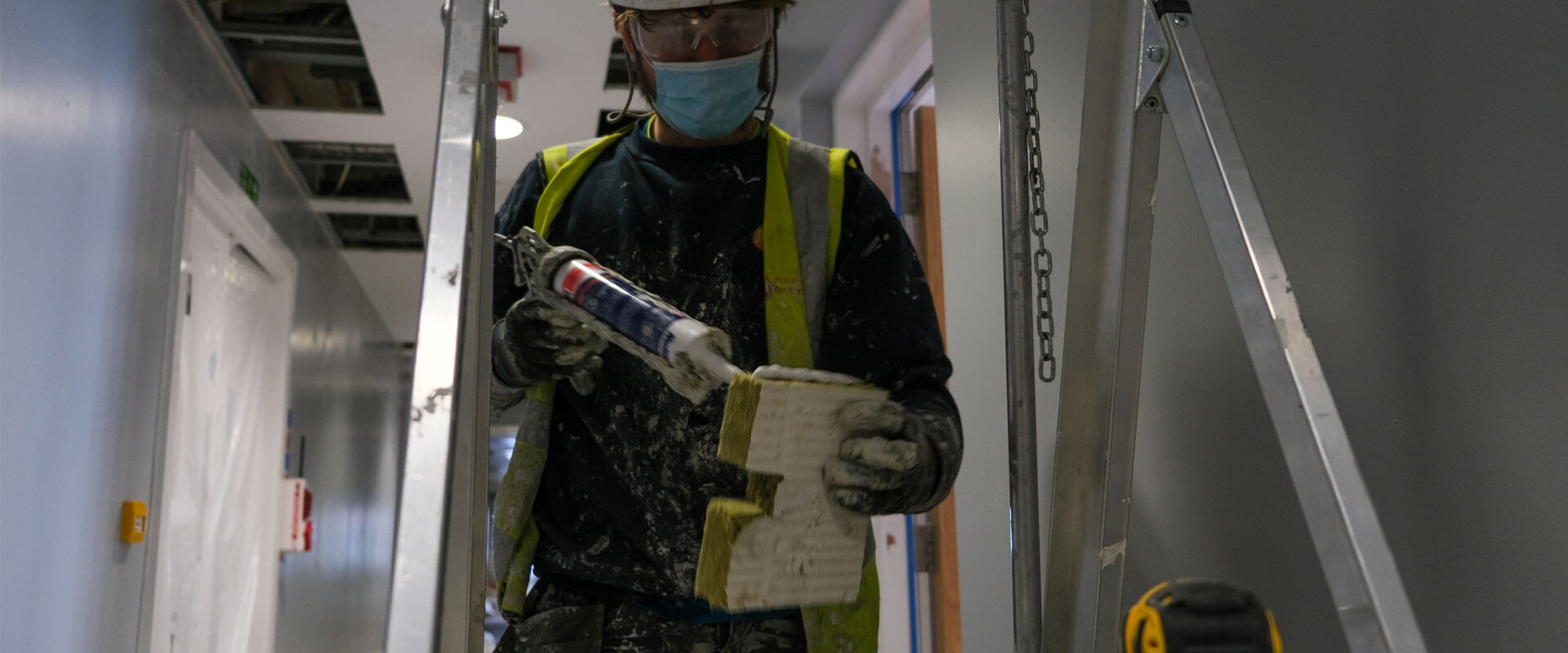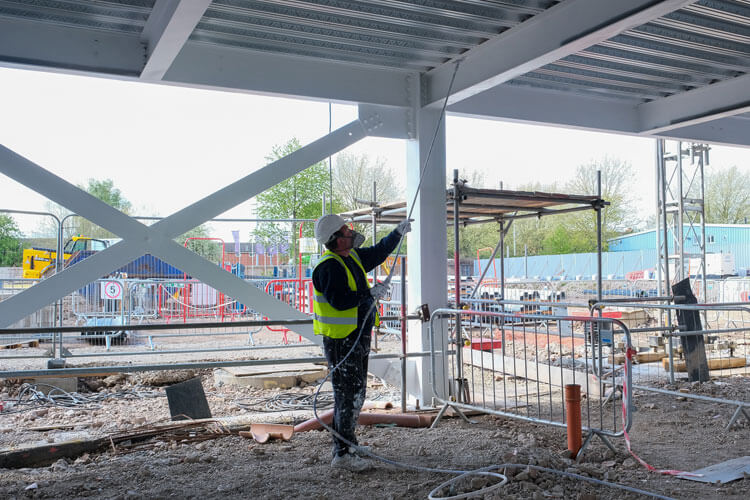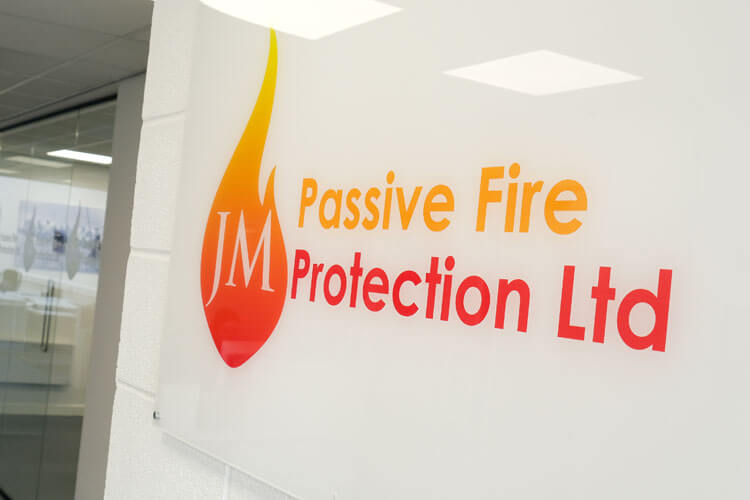
What Are Fire Stopping Batts?
Intumescent batts are one of many products available to protect buildings against the effects of damaging fire performance. They are a type of PFP which means that they’re built into the structure of the building with the aim being to limit the damage of the fire by containing it in one area.
In this case, the coated batts are designed to protect the steel structural framework of a building. They can be a mineral wool insulation product or a high-density fibreboard that are covered in an intumescent coating.
When there is a fire, the coated batts undergo a chemical reaction and swell when exposed to the heat of the steel. This then forms a protective layer.
The paint-like coating provides fire resistance for up to four hours, however, this will depend on the type of product used. Intumescent coatings can be available as thick and thin films, where thick coatings tend to be industry-specific and thin coatings being what is typically used.
Thick coatings can provide fire resistance for up to four hours with thin coatings providing protection for up to 2 hours.
Both measures provide a barrier of protection that prevents the building’s steelwork from collapsing in the event of a fire.

The Benefits Of Fire Batt Boards
There are various benefits to installing coated batts to your building’s structure with it being both an effective method and one of the easiest to install. When steelwork is used, intumescent coatings are often the preferred choice for these reasons.
- Fire Resistance
- Lightweight
- Peace Of Mind
- Cost-Effective
- Quick Installation
Fire Resistance
As mentioned, intumescent batts provide excellent fire resistance with the standard batts being able to protect the structure for up to 2 hours.
However, this will depend on various factors such as the amount of fire exposure, the critical temperature, and the fire rating. This is why it is best to have your intumescent coatings installed by a professional to ensure you have the best quality finish.
Lightweight
Intumescent coatings are lightweight and unintrusive, which can be applied to a range of surfaces including solid walls and floors, flexible walls, and even concrete floors.
Peace Of Mind
A primary reason to want an intumescent coating is for peace of mind knowing that your structures have fire resistance in the event of an emergency.
The coatings have good air tightness which comes with additional benefits such as providing an excellent acoustic performance that can prevent smoke from spreading.
Cost-Effective
Intumescent coatings are a fairly affordable method of PFP, but their cost-effectiveness becomes apparent with the fact that they are protecting the building’s structural elements.
Steel’s strength and resilience to fire decreases the more it is exposed to heat which threatens the quality of the structure. This can obviously be incredibly costly if the building’s structure collapses as a result.
Likewise, the aim of PFP is to contain the fire to certain compartments so that the damage of the fire is prevented from spreading elsewhere. This is important when also considering any valuables that may be inside the building, which may otherwise need replacing.
Quick Installation
Not only are intumescent coatings cost-effective to install, but they can also be installed quite quickly. That being said, the installation will depend on the size of the building and other factors such as the required layers and coating type.
For water-based intumescent coatings, expect to have to wait 4 to 6 hours for it to dry before applying an extra coat.
In terms of how long this process will take, building sizes and coating types are still crucial factors. For an Epoxy coating, you will need at least 24 hours to finish the coating.
Water-based solutions require at least 10 days, and solvent coatings will need 20 days or more. This ensures that the steel underneath is well-protected.
Why Choose JMPFP for Fire Batts Installation?
Our business is founded on more than two decades of experience and knowledge in the industry from our Managing Director, John Maguire.
Our projects have encompassed residential buildings as well as educational institutions, sports premises, venues, and train stations. Our specialist knowledge and variety of projects can assure you that you are in safe hands.

Fire Batt FAQs
Are Fire Batts A Legal Requirement In The UK For Fire Protection?
Fire batts and other protection methods are a legal requirement because they allow anyone inside the building to escape safely. Therefore, intumescent coatings are also seen as a requirement especially for steelwork public buildings where large numbers of people will gather such as offices, shopping centres and stadiums.
Do Fire Batts Provide Excellent Fire Resistance?
Fire batts provide a good level of resistance with a single thickness batt of 50mm being able to provide up to 4 hours’ fire resistance.
Do Fire Batts Need To Be Placed Within All Compartment Walls?
Fire batts should be placed within compartment walls but in a manner so that each compartment is separated. This prevents the fire or smoke from spreading from one area to another. Each compartment should be divided by elements such as ceilings, walls and floors.
This means that in the event of a fire, it is contained within one compartment to allow any occupants of the building to exit safely.
How Long Does Installation Take?
As previously mentioned, the installation process can vary depending on the building type, the type of coating, the number of layers and the time required to dry between each layer. This means that the installation of an intumescent coating can take from 24 hours for an Epoxy coating to around a month for solvent coatings.